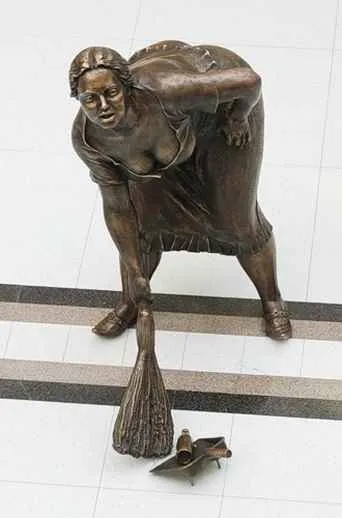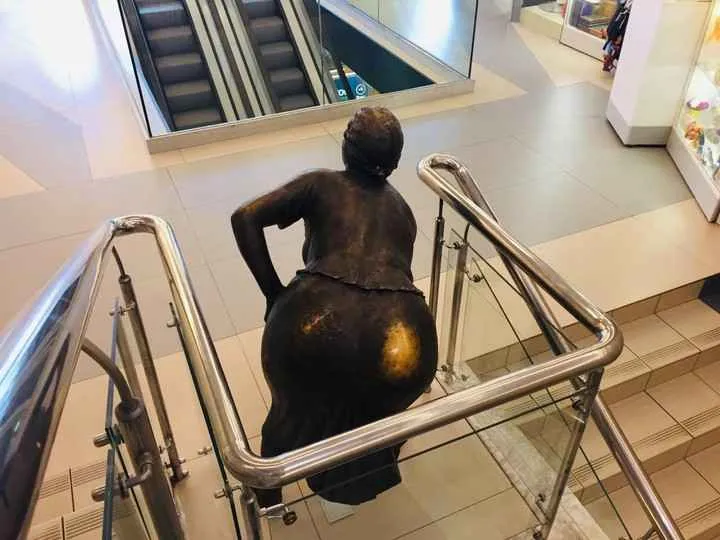In an unlikely spot for a monument—on the staircase landing between the second and third floors of a shopping mall in Moscow—stands a figure that doesn’t honor a war hero, a famous poet, or a historic leader. It’s a robust woman with a stern expression, dressed in Soviet-style clothing and holding a large broom. She is the Uborschitsa (The Cleaning Lady), a bronze sculpture that has evolved from a quiet tribute to an undervalued profession into one of the most curious—and most touched—monuments in the Russian capital.
A Monument to the Invisible
The sculpture, created by artist Vadim Kirillov, was designed in the early 2000s as part of a series honoring everyday professions. It was paired with a male counterpart: the “Sleeping Guard.” According to Kirillov, the goal was to pay homage to the hard, monotonous, but essential work of those who keep the city clean. The result was a deliberately exaggerated—almost caricatured—portrait of a Soviet-era cleaner: sturdy, focused, and unpretentious.
Originally installed in a business center on Nikolskaya Street, the statue was relocated several years ago to “Olimpik Plaza,” a shopping complex at 33 Prospekt Mira. There, she now silently greets visitors as if to remind them that cleanliness is a shared responsibility.
From Labor Tribute to Urban Legend
What began as an art piece with a social message gradually transformed into something else entirely. Over time, an unusual belief began circulating among students and mall visitors: if you rub a certain part of the statue—specifically her buttocks—and make a wish, it will come true.
This urban legend gained particular traction among university students hoping to pass exams, and the sculpture soon took on a second life as a good-luck charm. The most visible evidence of the ritual is in the gleaming surfaces caused by constant touching: the face, the chest, and, of course, the rear end of the statue shine as if polished with gold.
Today, although the figure is placed in a way that restricts access from three sides, that hasn’t stopped determined believers from seeking their magical contact. “Where there’s a will, there’s a way,” as the saying goes.
A Symbol That Transcends

Interpretations of the statue’s meaning are as varied as the people who touch it. Some see it as a well-deserved tribute to migrant women who came to Moscow in search of opportunity. Others jokingly refer to her as the “protector of girls from the provinces” who dream of conquering the capital. Still others focus on the broom she holds as a symbol of purity and order, beyond the statue’s curvaceous form.
Despite her humble appearance and origins, The Cleaning Lady has become a small but beloved icon of the city. Tourists stop to photograph her, Muscovites greet her almost like an old acquaintance, and even mall security guards admit they’ve made wishes at her feet. “At first we laughed about it,” one of them confessed, “but when we saw those wishes coming true, we started rubbing the statue too.”
A Lasting Figure
The original dustpan and empty bottle that once completed the scene have disappeared—likely during one of the statue’s relocations, though some suspect they were stolen by fans. Still, the essence of the work remains intact. It stands not only as a representation of a bygone era but also as a symbol of the dignity of invisible labor—of the ordinary, everyday work that rarely gets recognition.As sculptor Kirillov himself noted, the statue was never meant to grant wishes. And yet, perhaps unintentionally, it does. In a world where cleaning, sweeping, and tidying often go unnoticed, this bronze woman—with her focused gaze and firm grip on her broom—has achieved something remarkable: she has become a beloved, photographed, touched, and, most importantly, respected icon.


